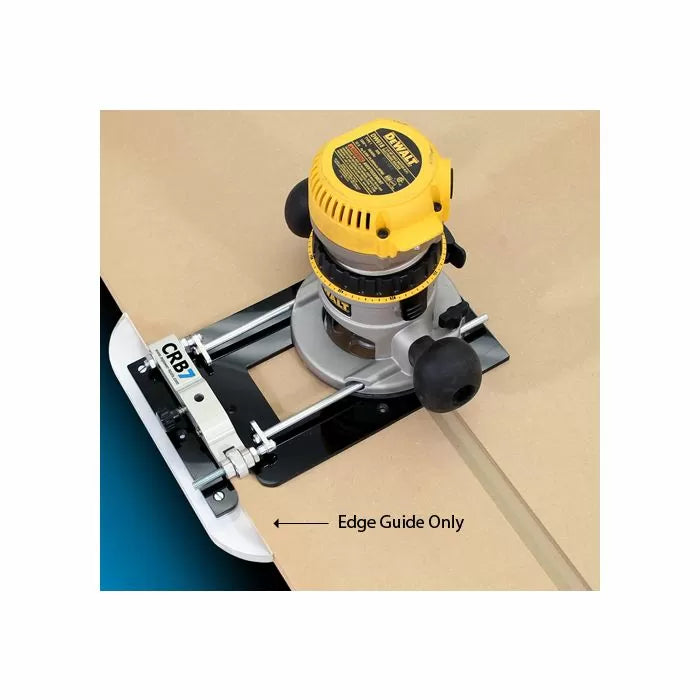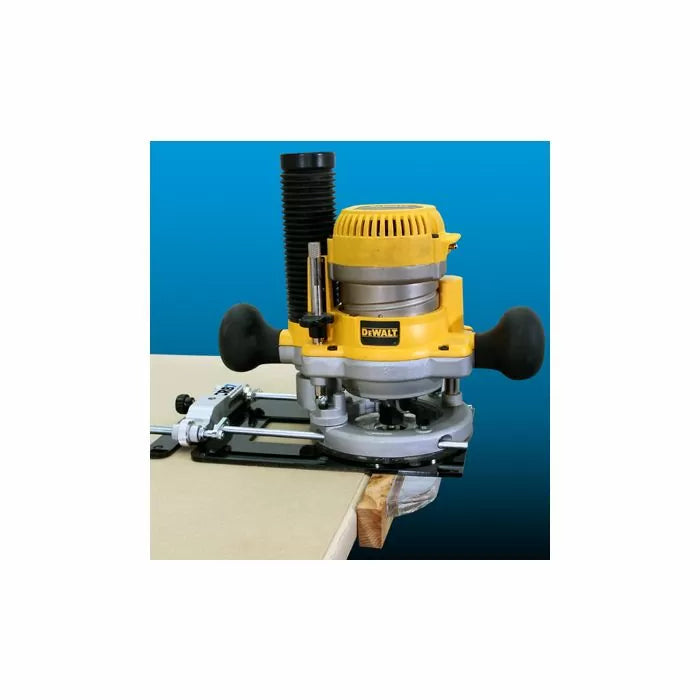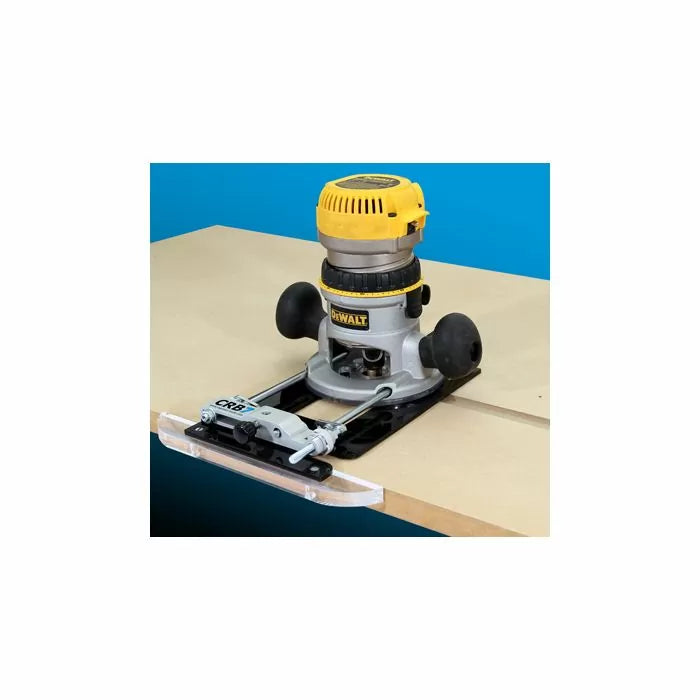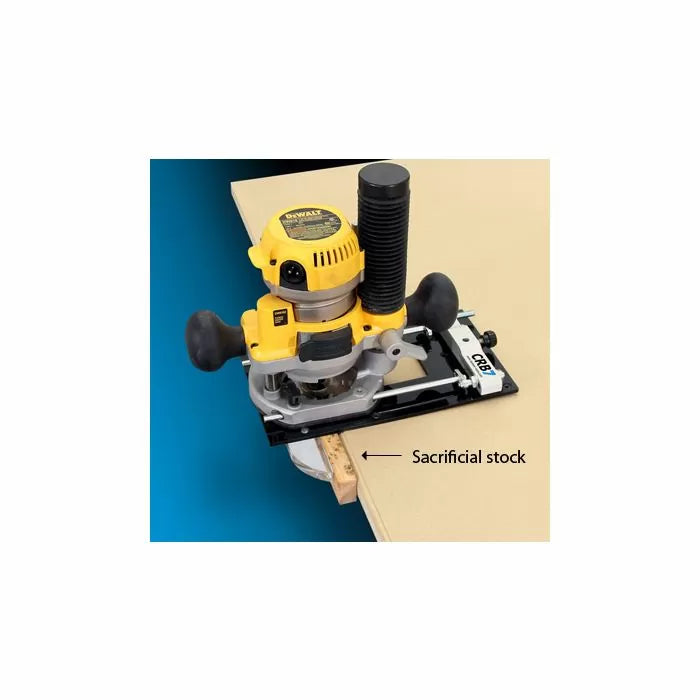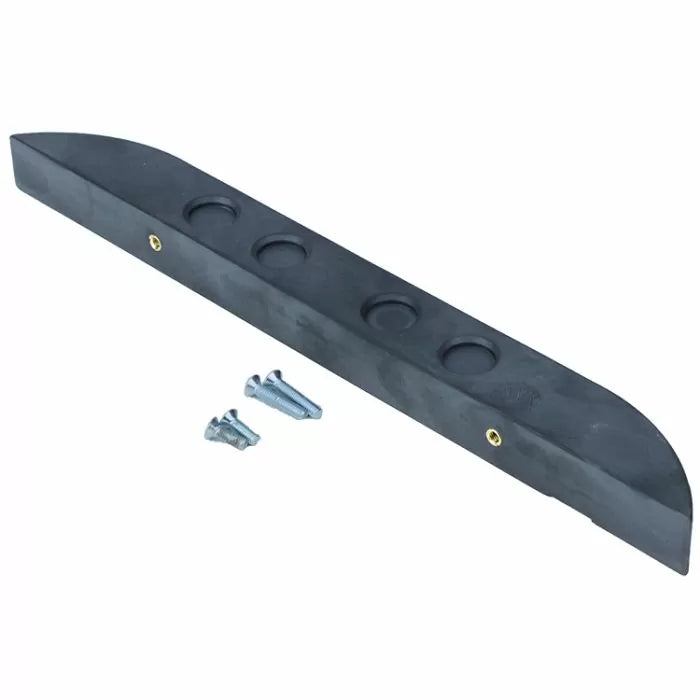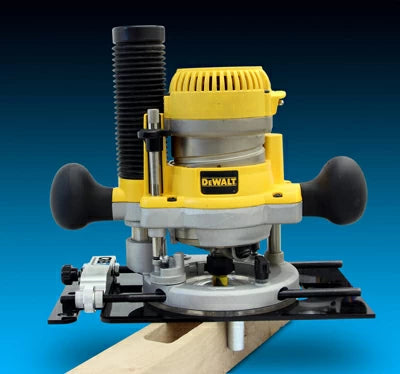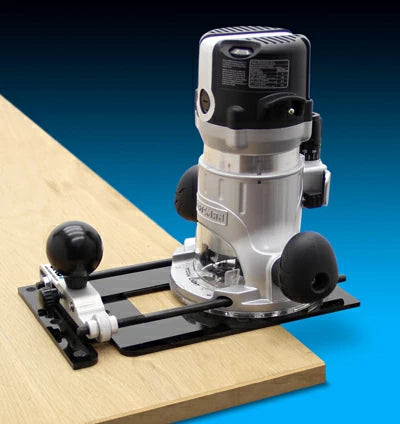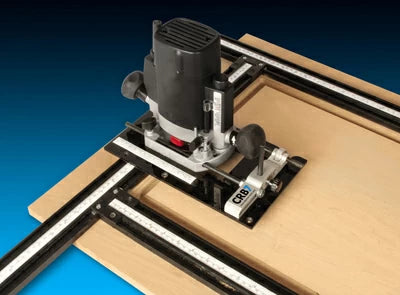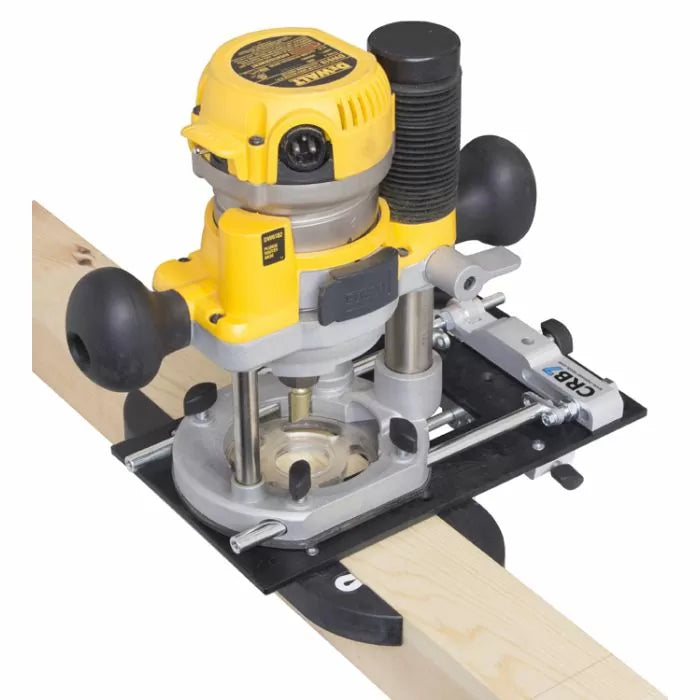Fitting this new parallel edge guide (side fence accessory) to your CRB7 base plate (100-097) gives you the ability to make dado cuts up to 7-1/2" from the edge of your stock without the use of a straight edge. Traditionally a router's edge guide is large, difficult to set up and has a disappointingly small range for dado cutting from the edge of your workpiece. In contrast, the CRB7 edge guide is breathtakingly simple and easy to fit to your CRB7 router base. It has a much greater range (from 0" to 7-1/2"), getting deeper in from the edge of the board with the accuracy your woodworking demands. This new edge guide also benefits from the accuracy of the CRB7’s micro adjuster which precisely controls the distance between cutter and the edge of the board. To make dadoing even more accurate, fit the CRB7’s 2” offset bridge handle (included with CRB7 Base, Part #100-097). The offset bridge handle locates the operator's hand almost directly over the board edge; giving you ultimate control over your woodworking dado cuts and making this accessory the most valuable routing dado jig in your shop!
Machined from solid ¾” clear Perspex plastic, 2 of its 4 brass threaded inserts attach it directly to the CRB7’s base plate. The other 2 inserts are located in the face of the edge guide allowing you to add a sacrificial piece of stock (see additional images). This sacrificial stock prevents damaging the edge guide with the back of the router cutter when edge molding. If you own or plan to buy the CRB7 Router Base Plate, you should strongly consider adding this accessory to your shopping cart.
Features include:
- Attached quickly and easily to your CRB7 router base with included hardware
- Guides your router accurately with a large range of adjustment (from 0" to 7-1/2")
- Uses the CRB7's micro-adjuster for ultimate dado cut fine tuning
- Fit the CRB7's bridge handle for even more control over your router
- Machined from a solid 3/4" thick piece of Perplex plastic for years of use in your shop
 MPower CRB7 Router Base Plate, Hinge Accessory, Trimming Accessory, Fence Accessory, and Mortise Hinge and Lock Accessory Package
MPower CRB7 Router Base Plate, Hinge Accessory, Trimming Accessory, Fence Accessory, and Mortise Hinge and Lock Accessory PackageA NEW WOODWORKER'S PERSPECTIVE ON TOOLS
Here is how the discussion went according to my recollection: "Hey Matt, I'm selling one of my routers. It comes with that blue table - the one on the rollers with the drawers - and a couple of other extras. You want it? Three hundred bucks."
"I guess. What's your layaway policy? Also, what's a router? Also, I'm going to be a few days late on the rent this month."
Six easy payments later and I was the proud owner of a quality router, which has proven to be one of the best investments I've made to date in the growth of my workshop. Surprising to say for a tool that at its core is just a small electric motor, but it is the router’s modular nature that makes it a must for the modern workshop. In my case, where said modern workshop space is fairly limited (and an operating budget that is even more so), a single tool that can be adapted to accomplish a variety of tasks will always find a place of preference in my toolbox.
So with all that in mind, you can imagine that I was quite excited to get my hands on the M Power CRB7 Combination Router Base, item #100-100 and its accessories. M Power packed a ton of potential into this addition to your existing router bases, and if you’re looking to expand your woodworking repertoire, it may be one of those investments to strongly consider.
The CRB7 Combination Router Base

For starters - and really, this is the crux of the matter - the basic package allows you to perform seven different router operations repeatedly with an extremely high degree of accuracy. In this you will have one tool that takes the place of seven different jigs and includes a unique method for making fine adjustments to the position of the cut itself. Can anyone ask for more?
The CRB7 attaches to your existing router base by way of two guide rods which purportedly can be adjusted to fit any size router base. The router bit operates within the borders of the large square opening on the baseplate, allowing for adjustments along the length and width. These adjustments made with the knurled tuning nut allow the user to place the cutting head exactly where it is needed and lock it there until it's time to make a change. Initial setup can take a bit of figuring out as the instructions that come with the attachment are rather dense and can be a bit confusing (at least to this beginner) but I eventually found that switching between functions was typically a very simple matter, usually involving the movement of one or two pins, screws, this, that, or the other.
The first thing that I knew I wanted to try was to cut a few mortises. I have been working for the past few weeks on a simple chest for my apartment to place, well, all the crap that I don't want to look at anymore that has followed me around since college. You know the stuff: orphaned electronics, cable, DVD's I never asked for, out-of-date reference books, an inexplicable boomerang. I'm basically making an Arc of the Future Yard Sale.
Anyway, after ruining one set of legs for this chest by improperly marking the borders of the mortises, I was keen to see if the M Power CRB7 would prove a more efficient means than just using my plunge base alone. By using the CRB7's hefty aluminum mortise pillars I was able to do just that. The pillars rode the outside edges of each leg and hugged it tight without binding thanks to their polished finish, keeping the entire router, the base, and the bit perfectly in place. For each new cut, all I needed to do was make small adjustments to the tuning knob and the bit rode straight and true with each pass.
I found that using just the aluminum mortise pillars on a square piece of stock that had been clamped to my workbench was a very stable setup, and I didn't experience any wobbling of the router. But let's say that I had. Perhaps the back of each leg was rounded over or the base of the stock was a bit narrow. In those cases, I found that the anti-tilt leg worked very well at keeping the whole arrangement from tilting over and ruining the cut. Just drop it in and tighten a nut and the leg acted as an extra point of stability.
With the chore of mortising out those legs completed, I went to another one of my sidelined projects, profiling the edge of a cherry and maple cutting board. If there is any place that the CRB particularly shines it is probably here. By setting the cutting edge towards the farther side of the baseplate you’re able to keep a larger footprint on the workpiece itself. In my case, this meant that there was more in contact with the face of the cutting board than was hanging off the edge. As such, I was able to run the router all the way around the cutting board and achieve a nice clean round-over without risking a tilt. Sure, a bearing bit will help prevent unintended damage to your piece during a cut on its own, but by adding the CRB7 the entire operation feels rock solid and you can cut all the way around the piece with a decisive, confident motion.
The rest of my tests went swimmingly, and if I sound like I’m gushing, it’s really because I am. The M Power CRB7 is a solid expansion for my router that opens up a host of possibilities for me as a new woodworker. I’ve been able to cut perfectly sized holes to expand and modify my dust collection system. I’ve created a perfectly indexed series of dadoes without having to make constant adjustments to my table saw fence. And I can do all of this with a greater feeling of control over the router - a tool that demands control.
Perhaps one of the best features of the CRB7 is that it is expandable beyond the basic package, so you can effectively keep the majority of your router operations localized to one tool family. The Edging and Trim Kit allows you to perform a new level of router operation that requires an extraordinarily fine touch and provides that extra bit of stability that can mean the difference between a seamless veneer job and a devastating error.
The idea for this expansion is solid: it’s essentially an additional baseplate with a large bearing that raises the base high enough to allow the cutting edge to trim edges and veneers. While the riser plate keeps the cutting head at the appropriate height above the workpiece, the bearing keeps the cutting head tracking over the edge you wish to cut without wavering off course.
What does this really mean to you? Well, when you consider that edge trimming requires the tip of your cutting edge to essentially hover above the surface of your piece at a width of a little less than that of a sheet of paper, the last thing you want is to accidentally pull that cutting edge to anywhere else on your workpiece. The bearing eliminates that possibility, allowing you to stay perfectly in line with the edge of your veneer, leaving you with one less thing to worry about while you’re using the tool, and the whole system glides nearly frictionless from the start of your cut to the finish. While it is possible to make your own edge kit without the bearing, that small but distinctive addition to the CRB7 creates peace of mind worth paying for.
A second supplement to the combination router base you can purchase is the Parallel Side Fence Kit. This 3/4" thick piece of Perplex plastic attaches to the underside of the CRB7 to give you the ability to cut dadoes up to 7 1/2" away from the workpiece edge. It’s very simple and performs a valuable function. It doesn’t hurt that it's also very well engineered. The Perplex plastic has been CNC machined and polished to be quite smooth, so even should you try working it across a rough plywood edge you’ll be hard-pressed to experience any snags or slowdowns. It attaches to the CRB7 base by way of two screws and stays solidly in place, and should you need to get very close with your cuts to, say, create shoulders, it is possible to attach a sacrificial fence with the extra mounting hardware included with the kit.
Simple though this accessory may be, it really rounds out the hardware nicely. M Power has really created something special with this line of router hardware, and it goes to show that even in a profession as time-tested and traditional as woodworking can be, there are still people who see the benefit of approaching old problems and practices from new angles.
UPDATED 5/15/2017:
Mortise, Lock, and Hinge Accessory
It's been a few years since I first wrote this article on the M-POWER CRB7 Router Base, so I wanted to add some information about the newest accessory that we've included to this package deal. The Mortise, Lock, and Hinge Accessory (Item 100-091) adds a whole new level of application to this system that I couldn't consider back when I was just starting out.
This accessory allows you to securely affix the CRB7 Router Base to the edge of any door or workpiece up to 7" wide and dial in the position of your mortises. With this, you can easily rout mortises for door hardware and hinges on both interior and exterior-sized doors.
I find it also handy for mortising out joinery for table legs and other spindly items. This accessory is also an improvement over using the Mortise Pillars because it will allow you to rout all the way over the edge of a workpiece where the mortise pillars would require you to stop short.

